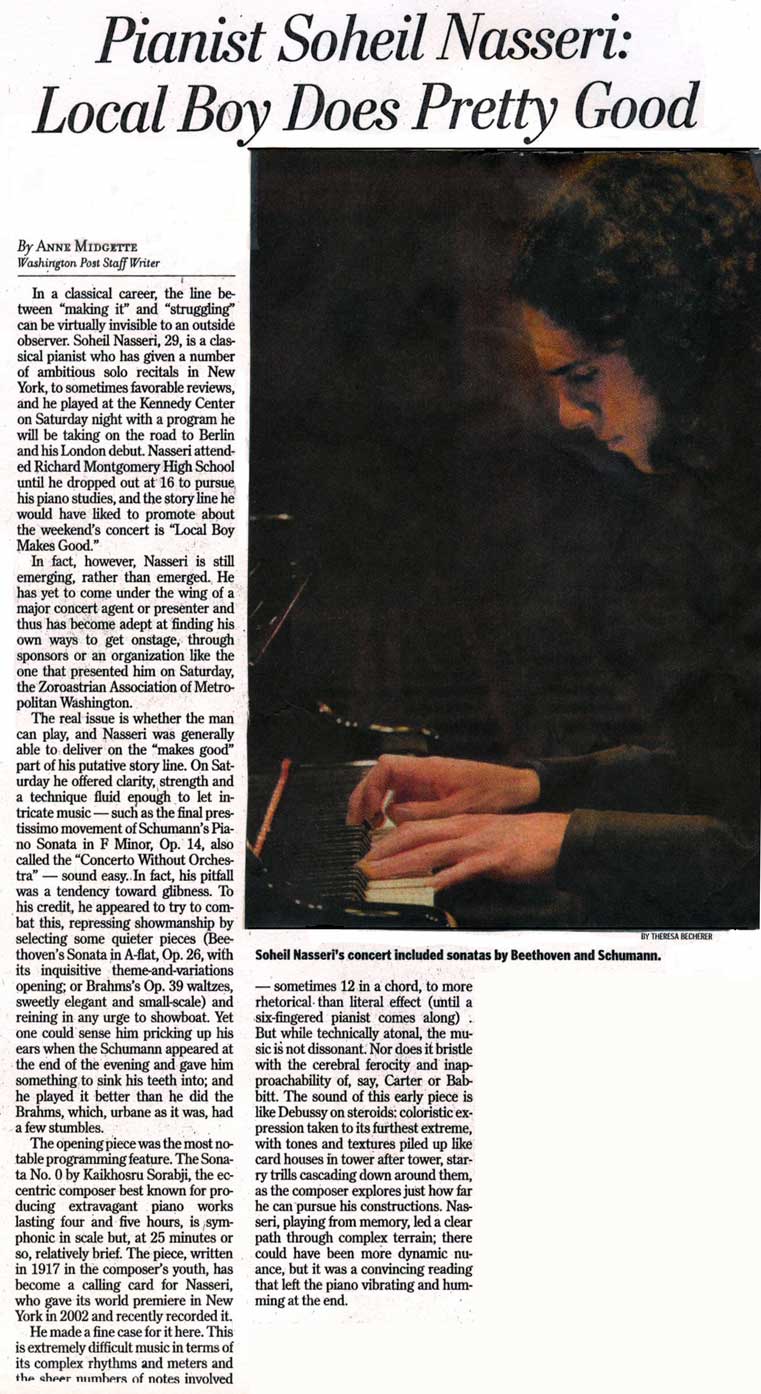Pianist Soheil Nasseri: Local Boy Does Pretty Good
Anne Midgette, The Washington Post
In a classical career, the line between “making it” and “struggling” can be virtually invisible to an outside observer. Soheil Nasseri, 29, is a classical pianist who has given a number of ambitious solo recitals in New York, to sometimes favorable reviews, and he played at the Kennedy Center on Saturday night with a program he will be taking on the road to Berlin and his London debut. Nasseri attended Richard Montgomery High School until he dropped out at 16 to pursue his piano studies, and the story line he would have liked to promote about the weekend’s concert is “Local Boy Makes Good.”
In fact, however, Nasseri is still emerging, rather than emerged. He has yet to come under the wing of a major concert agent or presenter and thus has become adept at finding his own ways to get onstage, through sponsors or an organization like the one that presented him on Saturday, the Zoroastrian Association of Metropolitan Washington.
The real issue is whether the man can play, and Nasseri was generally able to deliver on the “makes good” part of his putative story line. On Saturday he offered clarity, strength and a technique fluid enough to let intricate music — such as the final prestissimo movement of Schumann’s Piano Sonata in F Minor, Op. 14, also called the “Concerto Without Orchestra” — sound easy. In fact, his pitfall was a tendency toward glibness. To his credit, he appeared to try to combat this, repressing showmanship by selecting some quieter pieces (Beethoven’s Sonata in A-flat, Op. 26, with its inquisitive theme-and-variations opening; or Brahms’s Op. 39 waltzes, sweetly elegant and small-scale) and reining in any urge to showboat. Yet one could sense him pricking up his ears when the Schumann appeared at the end of the evening and gave him something to sink his teeth into; and he played it better than he did the Brahms, which, urbane as it was, had a few stumbles.
The opening piece was the most notable programming feature. The Sonata No. 0 by Kaikhosru Sorabji, the eccentric composer best known for producing extravagant piano works lasting four and five hours, is symphonic in scale but, at 25 minutes or so, relatively brief. The piece, written in 1917 in the composer’s youth, has become a calling card for Nasseri, who gave its world premiere in New York in 2002 and recently recorded it.
He made a fine case for it here. This is extremely difficult music in terms of its complex rhythms and meters and the sheer numbers of notes involved — sometimes 12 in a chord, to more rhetorical than literal effect (until a six-fingered pianist comes along) . But while technically atonal, the music is not dissonant. Nor does it bristle with the cerebral ferocity and inapproachability of, say, Carter or Babbitt. The sound of this early piece is like Debussy on steroids: coloristic expression taken to its furthest extreme, with tones and textures piled up like card houses in tower after tower, starry trills cascading down around them, as the composer explores just how far he can pursue his constructions. Nasseri, playing from memory, led a clear path through complex terrain; there could have been more dynamic nuance, but it was a convincing reading that left the piano vibrating and humming at the end.



